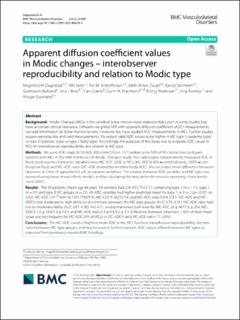| dc.contributor.author | Dagestad, Magnhild Hammersland | |
| dc.contributor.author | Vetti, Nils | |
| dc.contributor.author | Kristoffersen, Per M | |
| dc.contributor.author | Zwart, John Anker Henrik | |
| dc.contributor.author | Storheim, Kjersti | |
| dc.contributor.author | Bakland, Gunnstein | |
| dc.contributor.author | Brox, Jens Ivar | |
| dc.contributor.author | Grøvle, Lars | |
| dc.contributor.author | Marchand, Gunn Hege | |
| dc.contributor.author | Andersen, Erling | |
| dc.contributor.author | Assmus, Jörg | |
| dc.contributor.author | Espeland, Ansgar | |
| dc.date.accessioned | 2022-08-26T11:40:42Z | |
| dc.date.available | 2022-08-26T11:40:42Z | |
| dc.date.created | 2022-08-17T16:03:09Z | |
| dc.date.issued | 2022 | |
| dc.identifier.issn | 1471-2474 | |
| dc.identifier.uri | https://hdl.handle.net/11250/3013779 | |
| dc.description.abstract | Background
Modic Changes (MCs) in the vertebral bone marrow were related to back pain in some studies but have uncertain clinical relevance. Diffusion weighted MRI with apparent diffusion coefficient (ADC)-measurements can add information on bone marrow lesions. However, few have studied ADC measurements in MCs. Further studies require reproducible and valid measurements. We expect valid ADC values to be higher in MC type 1 (oedema type) vs type 3 (sclerotic type) vs type 2 (fatty type). Accordingly, the purpose of this study was to evaluate ADC values in MCs for interobserver reproducibility and relation to MC type.
Methods
We used ADC maps (b 50, 400, 800 s/mm2) from 1.5 T lumbar spine MRI of 90 chronic low back pain patients with MCs in the AIM (Antibiotics In Modic changes)-study. Two radiologists independently measured ADC in fixed-sized regions of interests. Variables were MC-ADC (ADC in MC), MC-ADC% (0% = vertebral body, 100% = cerebrospinal fluid) and MC-ADC-ratio (MC-ADC divided by vertebral body ADC). We calculated mean difference between observers ± limits of agreement (LoA) at separate endplates. The relation between ADC variables and MC type was assessed using linear mixed-effects models and by calculating the area under the receiver operating characteristic curve (AUC).
Results
The 90 patients (mean age 44 years; 54 women) had 224 MCs Th12-S1 comprising type 1 (n = 111), type 2 (n = 91) and type 3 MC groups (n = 22). All ADC variables had higher predicted mean for type 1 vs 3 vs 2 (p < 0.001 to 0.02): MC-ADC (10− 6 mm2/s) 1201/796/576, MC-ADC% 36/21/14, and MC-ADC-ratio 5.9/4.2/3.1. MC-ADC and MC-ADC% had moderate to high ability to discriminate between the MC type groups (AUC 0.73–0.91). MC-ADC-ratio had low to moderate ability (AUC 0.67–0.85). At L4-S1, widest/narrowest LoA were for MC-ADC 20 ± 407/12 ± 254, MC-ADC% 1.6 ± 18.8/1.4 ± 10.4, and MC-ADC-ratio 0.3 ± 4.3/0.2 ± 3.9. Difference between observers > 50% of their mean value was less frequent for MC-ADC (9% of MCs) vs MC-ADC% and MC-ADC-ratio (17–20%).
Conclusions
The MC-ADC variable (highest mean ADC in the MC) had best interobserver reproducibility, discriminated between MC type groups, and may be used in further research. ADC values differed between MC types as expected from previously reported MC histology. | en_US |
| dc.language.iso | eng | en_US |
| dc.publisher | BMC | en_US |
| dc.rights | Navngivelse 4.0 Internasjonal | * |
| dc.rights.uri | http://creativecommons.org/licenses/by/4.0/deed.no | * |
| dc.title | Apparent diffusion coefficient values in Modic changes – interobserver reproducibility and relation to Modic type | en_US |
| dc.type | Journal article | en_US |
| dc.type | Peer reviewed | en_US |
| dc.description.version | publishedVersion | en_US |
| dc.rights.holder | Copyright The Author(s) 2022 | en_US |
| dc.source.articlenumber | 695 | en_US |
| cristin.ispublished | true | |
| cristin.fulltext | original | |
| cristin.qualitycode | 1 | |
| dc.identifier.doi | 10.1186/s12891-022-05610-4 | |
| dc.identifier.cristin | 2043937 | |
| dc.source.journal | BMC Musculoskeletal Disorders | en_US |
| dc.identifier.citation | BMC Musculoskeletal Disorders. 2022, 23, 695. | en_US |
| dc.source.volume | 23 | en_US |

